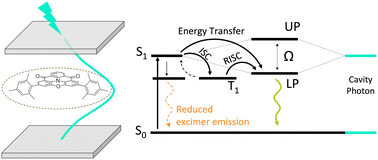Multi-resonance TADF in optical cavities: suppressing excimer emission through efficient energy transfer to the lower polariton states†
Abstract
Thermally activated delayed fluorescence (TADF) emitters suffer from molecular aggregation that limits their applicability in light emitting devices. Aggregation-induced excimer formation often leads to a larger Stokes shift, broader emission spectrum, and reduced emission quantum yields, limiting emitter dye loading to a few weight percent in organic light emitting devices. Here, we demonstrate suppression of excimer emission by dispersing a synthesised multi-resonance TADF emitter dye (OQAO(mes)2) in a PMMA host matrix and embedding the host–guest photoactive layer into an optical cavity. Rabi splitting up to 0.24 eV is obtained at 35 wt% dye loading. Under the strong coupling regime, prompt and delayed emission through excimer states is suppressed due to efficient energy transfer to the lower polariton (LP) states, demonstrated by the blue shift of the emission spectrum and narrowing of the emission linewidth. We also observe an increase in reverse intersystem crossing (RISC) rate constants up to 33% that we attribute to a decrease in activation energy by ≈2kT. This work highlights that strong light-matter interactions can be exploited to overcome aggregation-induced excimer losses providing a pathway towards efficient organic light-emitting diodes with high colour purity and organic semiconductor polariton lasing.



 Please wait while we load your content...
Please wait while we load your content...